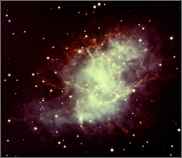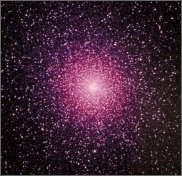
|
Pulsars |
|
Pulsars are rapidly-rotating neutron stars; the collapsed cores of supergiant stars that have exploded as supernovae. They are exceedingly dense, weighing more than our Sun, but the size of a city. They are highly magnetised. As the star spins, radio waves emerge as a beam above the magnetic poles. Sometimes these beams will sweep across the Earth's position in space and we see regular pulses of energy, much like the flashes from a lighthouse. Discovering Pulsars Thanks to the great sensitivity of the Lovell Telescope, Jodrell Bank has been at the forefront of pulsar research since their discovery at Cambridge in 1967. Over three quarters of the more than 1000 pulsars now known have been discovered by Jodrell Bank astronomers, often in collaboration with astronomers at the 64-metre Parkes Telescope in Australia. This telescope has recently been equipped with a 13-beam receiver system; the very low-noise amplifiers and much of the data acquisition hardware has been built by Jodrell Bank engineers. The survey using this fast, highly sensitive, system at Parkes is detecting one new pulsar for each hour of observation. Millisecond Pulsars One of the most surprising discoveries ever made by the Lovell Telescope was the finding of a very rapidly rotating pulsar in the globular cluster M28. As pulsars age they slow down and finally cease to radiate. Globular clusters are very old, and thus it was not expected that any would be found there. However, it seems that a close encounter between a neutron star and one of the myriads of stars in the cluster had "spun-up" and re-activated this pulsar whose period is now measured in milliseconds - hence the name. Many other globular clusters, like 47 Tuc (left), are now known to harbour millisecond pulsars. The fastest known pulsar rotates 642 times per second! Such pulsars are exceedingly good timekeepers and may even be more stable than the world's best atomic clocks. The Crab Pulsar A small 13-metre telescope continuously monitors the pulsar in the Crab Nebula, M1. (see left) Formed when its progenitor star was seen to explode in 1054, the Crab Pulsar is now spinning just less than 30 times a second and is gradually slowing down. However, every 18 months or so it is seen to increase its rotational speed suddenly, an event known as a "glitch". This is due to a change in the deep interior of the neutron star where some of the neutrons exist as a superfluid. By studying these events with a timing precision of one part in a trillion it is possible to probe the interiors of these astounding objects. Speeding through space With simultaneous observations by the Lovell Telescope and MERLIN, pulsar positions can be measured very precisely. Observations over a number of years have shown that some are moving through space at speeds of more than 500 km/sec! It appears that many new-born pulsars will be travelling so fast that they will escape the gravitational pull of our Galaxy and be lost into the depths of space. For more on pulsar research see the Pulsar Group Research Pages |

